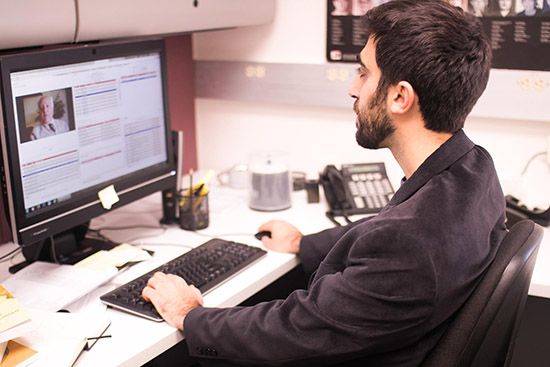Armenian Genocide Collection Indexing is Complete

Manuk Avedikyan indexes Armenian testimonies
All testimonies from USC Shoah Foundation’s Armenian Genocide collection have been indexed and will be integrated into the Visual History Archive in the coming months.
Indexer Manuk Avedikyan completed the last 88 of the 333 testimonies in the collection last week. The collection was first introduced with 60 testimonies that were added to the VHA on April 24, 2015, the 100th anniversary of the Armenian Genocide. Another 185 indexed testimonies were added to the collection in April of this year.
Indexing is the process of a researcher watching each testimony and using USC Shoah Foundation’s indexing software to assign keywords to each minute of the testimony, so that it can be fully searchable in the Visual History Archive. This process must be complete before the testimonies are integrated into the Archive.
The Armenian testimonies were taken by filmmaker J. Michael Hagopian for use in the 17 documentaries he made about Armenians and the Armenian Genocide. In 2010, USC Shoah Foundation signed an agreement with Hagopian, his wife, and the Armenian Film Foundation to integrate the testimonies into the VHA. It is the largest film collection of interviews of survivors and witnesses of the Armenian Genocide.
The largest film collection of Armenian Genocide testimonies is complete.
The final testimonies to be indexed were challenging for Avedikyan because they included testimonies in Arabic, Greek, and Kurdish -- three languages that weren’t previously in the VHA -- as well as French, German, and Spanish. Avedikyan had Institute interns and staffers who spoke those languages (aside from Kurdish, which he had to get a written translation of) verbally translate the testimony for him while he indexed. This was more efficient than hiring other indexers to do just one or two testimonies.
“I think that was the best way to do it, and it was among the first times that we’ve done it this way,” he said.
The last group of testimonies also include many unique experiences. One is that of Armenians and Greek in the Great Fire of Smyrna in 1922 during the Greco-Turkish War.
“Within the historical narrative I knew, the Fire was primarily an atrocity directed against Greeks, but there was a surprising level of anti-Armenian sentiment by Turkish soldiers that was revealed through the testimonies of the Greek survivors,” he said. “It was informative and a bit surprising to learn that Armenians were at certain moments singled out to be killed over Greek IDPs.”
Another is that of Muslim Armenians in Syria, a group that Avedikyan claims is on periphery of Armenian society and is discussed far less than of the Muslims Armenians in Turkey.
“Generally speaking, it would have been nearly impossible for Hagopian to film Islamized Armenians in Turkey, especially in the late 80’s,” he said. “But Syria is a different story, many of the testimonies suggest very good relations between Arabs and Armenians and stories of Arabs aiding Armenians when in need.”
In addition to testimonies from survivors of genocide and those around them, the collection also includes testimony from many Armenian Genocide scholars, including a contingent of German scholars speaking about German complicity in the genocide.
“There are very well-known scholars in the collection and they could be used as a great educational resource,” Avedikyan said. “They provide historical context or specific topics pertaining to the Armenian Genocide rather than testimony like the majority of interviewees who are survivors.”
Next up for Avedikyan and the collection is translating the testimonies that are in foreign languages, subtitling the testimonies, and updating the research terms included in the glossary. The subtitling will be completed in early 2017.
“There is still much more work to do on this collection,” he said.